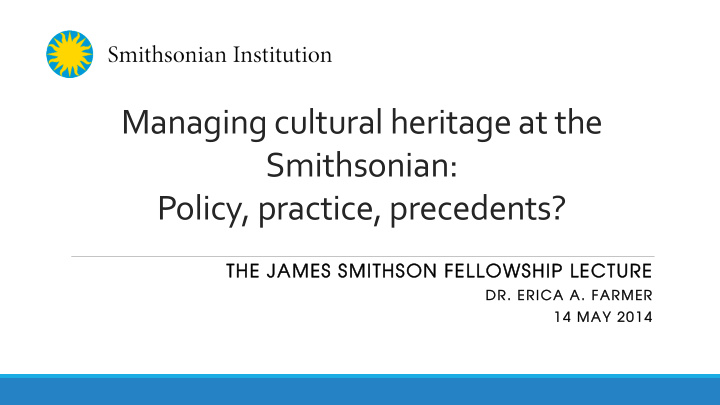



Managing cultural heritage at the Smithsonian: Policy, practice, precedents? THE J E JAMES ES S SMITH THSON FELLOWS WSHIP LE LECTURE RE DR. R. E ERICA A A A. FARM RMER 14 14 MAY 2014 2014
Connections to contemporary anthropology Anthropology of organizations Legal anthropology Applied anthropology Cultural revitalization Visual and digital anthropology
Cultural property/culture as property WHAT IS CULTURAL HERITAGE AND WHY DOES IT MATTER?
Defining cultural property • “movable or immovable property of great importance to the cultural heritage of every people, such as monuments of architecture, art or history, whether religious or secular; archaeological sites; groups of buildings which, as a whole, are of historical or artistic interest; works of art; manuscripts, books and other objects of artistic, historical or archaeological interest; as well as scientific collections and important collections of books or archives or of reproductions of the property defined above” -- 1954 Hague Convention, Article 2(a)) • "the term 'cultural property' means property which, on religious or secular grounds, is specifically designated by each State as being of importance for archaeology, prehistory, history, literature, art or science" – 1970 UNESCO Convention, Article 1
Changing concepts of cultural heritage • Shift from buildings to moveable items of cultural significance to intangible elements of culture • Shift from looking to more universal concept of Culture and heritage tied to lure of antiquity and origins of civilization to include more localized, everyday expressions of living societies • Broadening of protection via more anthropological ideas of what culture and heritage are
UNESCO Intangible Cultural Heritage convention (2003) The ‘intangible cultural heritage’ means the practices, representations, expressions, knowledge, skills – as well as the instruments, objects, artefacts and cultural spaces associated therewith – that communities, groups and, in some cases, individuals recognize as part of their cultural heritage. This intangible cultural heritage, transmitted from generation to generation, is constantly recreated by communities and groups in response to their environment, their interaction with nature and their history, and provides them with a sense of identity and continuity, thus promoting respect for cultural diversity and human creativity. UNESCO 2003: Art 2 §1
A research question… HOW DOES POLICY AROUND CULTURAL PROPERTY/CULTURAL HERITAGE GET MADE AT THE SMITHSONIAN?
Wha hat i is po policy? ? “ A principle or course of action adopted or proposed as desirable, advantageous, or expedient; esp. one formally advocated by a government, political party, etc. Also as a mass noun: method of acting on matters of principle, settled practice.” – Oxford English Dictionary “a : a definite course or method of action selected from among alternatives and in light of given conditions to guide and determine present and future decisions b : a high-level overall plan embracing the general goals and acceptable procedures especially of a governmental body”– Merriam Webster
Approaches and techniques institutional ethnography– “studying up” review of formal and informal documents and practices case studies tracing relationships and connections
Where does this happen? "like it or not, the whole joint is doing cultural heritage policy” Who should be doing this? Specific concerns tied to specific parts of the institution ◦ CFCH/ Folkways ◦ NMAI ◦ NMNH
Missi ssions and d duties Connections between visions and policy choices-- decisions and balancing of interests The idea of "case-by-case" decisionmaking Expertise and authority Who are we speaking for? Who are our constituencies? Proactive vs. reactive strategies– shifting defaults
Missions and duties Things to think about… • What are our values and how do we express them? • What are the ways in which the role of the Smithsonian raises additional concerns or opportunities? • How do perceived duties change over time ?
Precedents What are people referring to when they evoke “precedent” and why does it matter? • questions of scale • concerns and benefits from precedent setting • ability to recast narratives • different objectives and motivations
Expanding roles “We should be the major museum player or representative making these arguments. I think we should function as a Secretariat for museums and material culture. It should be almost a Cabinet style role. After all, who else is in a position to advocate for these things?” "Our goal at the Center is connecting people and heritage. I see that as civic engagement and cultural participation. It's a civil society type of vision."
Recommend
More recommend